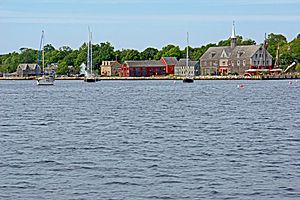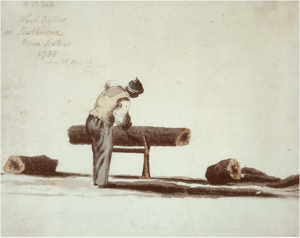Stephen Blucke facts for kids
Quick facts for kids
Stephen Blucke
|
|
|---|---|
| Born | c. 1752 |
| Died | after 1796 |
| Occupation | soldier and teacher |
| Years active | 1777–1792 |
| Title | Colonel |
| Spouse(s) | Margaret Coventry |
| Children | Isabel Gibbons |
| Military career | |
| Allegiance | |
| Service/ |
|
| Years of service | 1775–1783 |
| Rank | Colonel (honorary rank) |
| Commands held | Black Company of Pioneers (1777-1780) and Black Brigade (1780-1783) |
| Battles/wars | American Revolutionary War
|
| Signature | |
 |
|
Stephen Blucke (born around 1752 – after 1796) was a brave Black Loyalist during the American Revolutionary War. He was a leader in the British army's special unit called the Black Company of Pioneers.
After the war, Stephen Blucke was one of about 3,000 people who sailed from New York to Nova Scotia, Canada, on British ships. He settled in Birchtown, Nova Scotia, a town created for African-Americans. He became an important leader there, working as a magistrate and a military officer. He helped plan the town and organize work for roads. Stephen Blucke lived a comfortable life, unlike many of his neighbors who were very poor. He had a strong, well-built house, while most people lived in simple shelters. He also helped people find jobs.
When Blucke first arrived in Birchtown, he was married and had an adopted daughter. His wife later moved away. He became a schoolteacher, but the school closed when many people left Birchtown for Sierra Leone in 1792. Stephen Blucke left Birchtown quietly around 1796 or 1797.
Contents
Stephen Blucke's Early Life
Stephen Blucke was born around 1752 in Barbados. He was a mixed-race person, with a Black mother and a White father. He could read and write well. He later moved to New Jersey in the American colonies. There, he met Stephen Skinner, who would become an important person in Nova Scotia. Blucke decided to fight with the British army against the American colonists who were rebelling.
He married Margaret, a Black woman born free in New York around 1743. Margaret had bought her own freedom when she was 14. Her family was mostly free and had some money. Margaret bought Isabel Gibbons to free her, and Isabel became Stephen and Margaret's adopted daughter. Isabel was born around 1763. In 1784, Stephen, Margaret, Isabel, and two servants lived in their Birchtown home. Stephen's mother also came to live with him in Birchtown by 1789.
While living in Birchtown, Stephen Blucke and Isabel had a daughter named Frances. Frances was baptized in 1796, and Isabel took Blucke's last name.
Stephen Blucke and the American Revolution
During the American Revolution, a brave Black Loyalist leader named Colonel Tye died in 1780. Stephen Blucke then took command of another Black Loyalist group called the Black Brigade. He was given the special title of "Colonel."
The Black Brigade was a skilled group of fighters within the Black Pioneers. The Black Pioneers were Black Loyalist soldiers who did labor work for the British Army. At first, the Black Brigade fought on their own. Later, they joined forces with the Queen's Rangers, a White British army group. The Black Brigade operated in New York and New Jersey. They focused on specific targets. Before Stephen Blucke left for Nova Scotia, he received a certificate of freedom from General Samuel Birch.
Black Loyalists and the British Army
During the Revolutionary War, the British army realized they needed more soldiers. They promised freedom to any enslaved people who belonged to the American rebels if they would help the British. About 30,000 enslaved people ran away from their owners to join the British. They worked as cooks, pilots, laborers, musicians, and soldiers.
After the war, many White Loyalists decided to leave the United States. They settled in Port Roseway, which is now called Shelburne, Nova Scotia. In May 1783, about 3,037 people arrived there. This group included 415 servants, some of whom were enslaved.
Life in Nova Scotia
Stephen Blucke was one of about 3,000 free or freed Black Loyalists who could go to Nova Scotia. He arrived in The Maritimes in British Canada in August 1783 on a ship called L'Abondance. He first settled in Port Rosey (now Shelburne, Nova Scotia) with many other Black Pioneers.
He worked with Benjamin Marston, the main surveyor, to find land for the Black Loyalists. The land they found was near a swamp and had sharp rocks. Some people think Blucke accepted this land to avoid problems with wealthy White settlers and to get everyone settled quickly. Six groups of African Americans were formed. Each group had a captain, and Stephen Blucke was the overall leader.
On September 3, 1783, they began to build their new town, which became Birchtown, Nova Scotia. It was named after Samuel Birch, who signed the freedom papers for the Black Loyalists. Birchtown was created just for people of African descent. In 1784, Stephen Blucke and other residents were listed on the Birchtown Muster roll. They built simple shelters that were not very good for people from warmer climates. Stephen Blucke built the only well-made house in Birchtown.
There was a four-year delay before residents actually received their land. Most people received up to 40 acres. Blucke, however, received a 200-acre plot. This was likely because of his important role in working with both White and Black communities. He might also have saved some money from the war. Even though the soil in Birchtown was not good for large farms, Blucke had a big garden at his house.
Blucke built a boat to go fishing. He became friends with Stephen Skinner, a local merchant. Skinner often hired Black people through Blucke. Many Black Loyalists did not receive the land they were promised. They had to work as laborers or house servants. Some became sharecroppers, meaning they farmed land for others in exchange for a share of the crops. Skinner may have helped Blucke a lot.
There was an Anglican church in Birchtown. To attend, people had to pay to rent a seat. Stephen Blucke was the only resident who could afford this.
Birchtown stayed together for eight years, even with hunger, a race riot, a lot of poverty, and the understanding that, even though they were free, African-Nova Scotians had to fight hard for fair treatment and equal rights.
Stephen Blucke was sometimes called the "Birch Magistrate." He helped people ask the government for things, witnessed property sales, and helped keep order. Governor John Parr of Nova Scotia made him a lieutenant-colonel in the Black Militia for the Shelburne District in September 1784. Under his leadership, the Black Militia did public works, like building a road to Annapolis. He has been called "the true founder of the Afro-Nova Scotian community."
He also became a teacher at one of the Bray Schools. He received a good review from the school inspector. In early 1792, many Black Loyalists left Nova Scotia for Sierra Leone. Because there were so few students left, the school closed in 1796. The remaining Black residents, about one-fifth of the original population, left Birchtown for other areas. There were few jobs or opportunities left in Birchtown. In 1796 or 1797, Stephen Blucke quietly left Birchtown.
Studying Stephen Blucke's Home
Archaeologists studied the site of Stephen Blucke's house. They found evidence that he lived in a comfortable and well-built home. This showed that he lived a middle-class life, while most people around him in Birchtown were very poor. In 1998, during the archaeological dig, more than 13,000 items were found.
Most of the items were kitchen things, like tools for cooking, storing food, or eating and drinking. The next largest group of items were parts of the house itself, used in its construction. They also found tobacco pipes, clothing, weapons, personal items, and things used for daily activities from Blucke's home. Some older items from First Nations people were also found. These items found at Blucke's house are special compared to other sites in Birchtown. They are of very good quality, like the kitchenware, and there were many of them.
See also
- Deborah Squash, another Black Loyalist who lived in Birchtown, Nova Scotia




